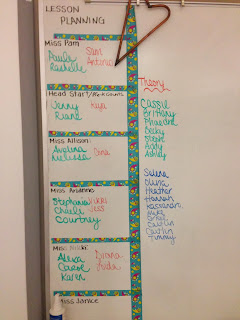Visual Learner - Jackie Steer
If you are a visual learner, you prefer
using images, pictures, colors, and maps to organize information and
communicate with others. You can easily visualize objects, plans and outcomes.
This is the Early Childhood Task List. The students are able to identify the tasks that they have accomplished and see the ones that they still need to work on. It is a visual tracking guide for them.
 The preschool early learning standards are located on the walls for the students to refer back to when they are developing their lesson plans. They also have the preschool standards books to use as a reference.
The preschool early learning standards are located on the walls for the students to refer back to when they are developing their lesson plans. They also have the preschool standards books to use as a reference.
Every morning I list on the white board what they need for the day. Their journal is listed on the board, their task number from the task list, the objective for the week, and what the theory members and the field member need to turn in that week. The picture on the right shows the preschool classrooms and the students that will be in field for the two week rotation.
 The preschool early learning standards are located on the walls for the students to refer back to when they are developing their lesson plans. They also have the preschool standards books to use as a reference.
The preschool early learning standards are located on the walls for the students to refer back to when they are developing their lesson plans. They also have the preschool standards books to use as a reference. Every morning I list on the white board what they need for the day. Their journal is listed on the board, their task number from the task list, the objective for the week, and what the theory members and the field member need to turn in that week. The picture on the right shows the preschool classrooms and the students that will be in field for the two week rotation.
In my classroom, I provide many visuals for these types of
learners. Front and center of my white board, the students see their Task
number from their Early Childhood Task List and the objectives they will be
learning while exploring the chapter. Each morning we have a specific warm-up
for each day of the week. Everyday the students know what their journal will
be. I also list the theory work for them to accomplish throughout the time they
are in their theory rotation. On the other side of the board, I have listed
each preschool teacher and the students that will be rotating for those two
weeks. In a pocket chart, students will find all the necessary papers they are
required to fill out for field. I also keep missed work for absent students as
well as enrichment activities in there if a student would like extra work. The
two bulletin boards in my room have information regarding their program,
Students Occupationally and Academically Ready (SOAR) as well as important
dates they need to be aware of. The other bulletin board is to show case the
student’s hard work and effort on projects. The early childhood standards for
preschool are hanging up around our room so they can always refer back to them
when they are developing their lesson plans. Open-ended questions are listed
above my white board for the students to keep in mind how to increase language
comprehension in the preschool children.
On one corner of the room you can find a vocabulary word
wall that has the vocabulary words and chapters the words come from. On the
back is the definition of the vocabulary word.
Students are encouraged to test each other in a vocabulary review game.
We take advantage of the fact that we have mac laptops and
Ipads in the classroom. These tools help the visual learners design and create
lessons and projects. I try to
incorporate youtube videos that relate to what they are learning about.
When we take notes, I either have a powerpoint with guided
notes or I use the ELMO in the classroom to project important information. When
we go over our math journal every Wednesday, I have students come up to the
white board, smart board, or ELMO to show the class how they solved their
answer.
One of the most important visuals is the preschool classroom
itself. The students take on the role of a teacher assistant and have to scan
the classroom for behaviors, student needs and requests.
Other things to take into account for visual learners are:
·
Add diagrams to your notes whenever
possible.
·
Dates can be drawn on a time-line
·
Organize your notes so you can
clearly see main points and supporting facts and how things are connected.
·
Connect related facts to your notes
by drawing arrows.
·
Color-code your notes with
highlighters so that everything related to a topic is the same color.
·
Use color, layout, and spatial
organization in your associations, and use many 'visual words' in your
assertions.



 Ov
Ov

No comments:
Post a Comment